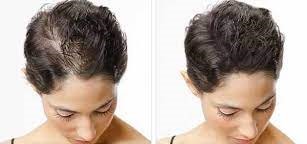Female alopecia in pre-menopause and menopause, and scalp micropigmentation, as a non-invasive camouflage treatment for alopecia.

Today I want to talk about a topic that I am beginning to meet, and they are women between 45 and 50 years old who come to me to ask for information on tricopigmentation or scalp micropigmentation.
The most frequent question they ask me is if scalp micropigmentation can hide the bald spot that is appearing. That for some time at this time they are either in the premenopausal phase (they are already beginning with hormonal imbalances) or they are already in the menpausal phase.
But what is menopause, that state that every woman ends up going through sooner or later. I’m going to give you a brief reminder of what menopause is, and so we can understand it, and return to the post.
“Menopause is the time in a woman’s life when she stops having periods. It usually occurs naturally, more frequently after age 45, and occurs because a woman’s ovaries stop producing hormones, which in this case are estrogens and progesterone.
We speak of a woman reaching menopause when she does not have a menstrual period for a year (that is, we take as a reference the fact that she has not had any menstrual cycle in a period of 12 consecutive months). The changes and symptoms can begin several years before that loss. Among the changes that are being found are:
Change in menstruation: More or less lasting, more or less profuse, with more or less time between periods
Heat and / or night sweats
Difficulty to sleep
Vaginal dryness
Humour changes
Difficult to focus
Less hair and more facial hair
As I have already commented previously, there begins to be a hormonal imbalance, and one of the consequences is that the secretion of estrogen, which are female hormones (hence, hormone replacement therapy is usually advised in certain cases) begins to decrease, and testosterone and androsterone increase. This is what will cause hair loss (female androgenic alopecia) and the appearance of more hair (alopecia is found more commonly in men than in women, and even so, this does NOT mean that the mere fact of being In the premenopausal or menopausal phase it implies hair loss, but there is a percentage of cases in which this symptom does occur due to the hormonal alteration that occurs in this situation).
The androgenic alopecia female occurs by increasing the influence of certain male hormones (I mentioned above) which they do is block the hair follicles and the hair impair develops. However, the effects in women are different and generally not as drastic as in the case of men.
That is, it is not as visible as in men, it is very rare to find bald women, but what is observed, and especially if they have long hair, that they have very depopulated areas.
Normally we find ourselves with a loss of the number of hairs, that is, we find that their hair is less dense, and the hair is thinner.
The loss is gradual and is usually observed in the highest area of the hair, where it is born, and in this area, the loss of hair is visible, especially if the woman has dark hair, since the skin is visible through the hair that is now finer, or it is also observed more if it is combed with a parting in the middle since it easily allows the root to be seen. The result is that an area where there is less hair becomes clearly visible.
There are treatments to reduce the impact of this baldness because let’s not forgotten that these types of impacts decrease the self-esteem of the person who suffers it.
Among the treatments aimed at reducing these impacts are hair stimulation treatments that are low-power laser and platelet-rich plasma, another more definitive treatment is hair scalp microimplantation, and another treatment is tricopigmentation or hair micropigmentation.
Hair or scalp micropigmentation does NOT replace hair, it consists of simulating the hair follicle through micropigmentation in those areas where there is no longer hair, but we find a bald spot.
In these cases of alopecia, it is usually quite satisfactory, since the woman continues to have her hair and the “holes” are hidden.
It usually takes two sessions, and normally lasts about 3 years, and they can lead a normal life from the first moment. And never forget that it is not hair.
It is a complex technique, especially due to the skill required to perform the follicles, so the sessions are usually long (approximately 2 hours)
Next, I show you a case made by me.
